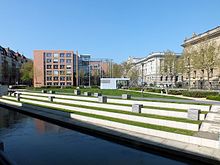Violin Concerto in E minor (Mendelssohn)
The Violin Concerto in E minor, Op. 64 ( MWV O 14 ) is a classical orchestral work by the composer Felix Mendelssohn Bartholdy . As early as July 1838, Mendelssohn had announced to his friend the violinist Ferdinand David : “I would like to give you a violin concerto for next winter; one in E minor stands in my head, the beginning of which leaves me with no peace. "
Six years later, in 1844, the violin concerto was completed in Bad Soden . It was premiered on March 13, 1845 in Leipzig with Ferdinand David as soloist.
Mendelssohn had already written a violin concerto in D minor in 1822 at the age of 13. The youth work rejected by Mendelssohn was made accessible to the general public by Yehudi Menuhin .
Orchestration
Solo violin , two flutes , two oboes , two clarinets , two bassoons , two horns , two trumpets , timpani and strings .
To the music
Mendelssohn's Violin Concerto contains some compositional innovations. For example, it contains a hitherto unusual seamless transition from the first to the second sentence. The main theme of the first movement is also heard in the solo instrument, the violin, and not, as usual, in the orchestra. Moreover, lets Mendelssohn the cadence contrary to the habits not the end of the first movement sound, but already in the implementation .
1st movement (Allegro molto appassionato)
After a brief introduction by the orchestra, the violin begins in the second bar with a lively theme, which is accompanied by the strings in the background; While the theme is being developed, the orchestra answers with short but specific tutti. The orchestra then takes on the violin theme and varies it, which is followed by a dialogue between the violin and alternating strings and then winds. Then it is up to the winds to take up a variation on the theme, which is repeated by the violin and is further developed with the accompaniment of the winds, who repeat their variation briefly in between. Suddenly the violin repeats its main theme, this time more energetically, and tries out all possible variations with the accompaniment of the orchestra as if driven. A crescendo from the orchestra ends the variations; now it is the turn of the violin with the cadenza. After the cadenza, the orchestra repeats the main theme of the movement on the piano and is accompanied by the soloist in a fast arpeggio . The violin takes on the task of varying the theme; after a while the winds and strings alternate as accompaniment. A dialogue between violin and orchestra slowly but surely leads to a series of powerful chords that give the bassoon the task of leading the way to the second movement.
The Fulda Symphony Orchestra plays.
2nd movement (Andante)
After the passage of the bassoon is continued by the strings, the violin responds with a longing theme, the development of which is accompanied by the violin by the strings. In the middle of the movement is a flowing melody from the orchestra, which is repeated by the violin and varied with a painful undertone. These variations are picked up by the orchestra accompanied by the violin. The violin continues with the variations, accompanied by the orchestra, until it finally takes up its main theme of the second movement. The peaceful development of the melody leads to the end of the movement, which is marked by the solo violin.
The Fulda Symphony Orchestra plays.
3rd movement (Allegretto non troppo - Allegro molto vivace)
After an introduction by the violin, a wind fanfare sounds; this is followed by a cheerful violin melody. A lively dialogue develops between violin and orchestra, until this comes up with a new theme, which the violin takes up and varies. This in turn leads to a lively dialogue between violin and orchestra, until the violin plays its cheerful melody again from the beginning of the movement and develops it further with the accompaniment of the strings, with the orchestra also responding to its theme. Violin and orchestra chords conclude the concert.
The Fulda Symphony Orchestra plays.
effect
The violin concerto was a success from the start and is now one of Mendelssohn's most popular works. In the 19th century, by the end of which it was already one of the greatest violin concertos in literature, it was part of the repertoire of leading violinists such as Ferdinand David , Joseph Joachim and Pablo de Sarasate . Subsequent composers such as Jean Sibelius and Peter Tchaikovsky were also inspired by the unusual placement of the cadenza.
Trivia
In 2007, the Pleißemühlgraben , which has been vaulted since the 1950s, was reopened in Leipzig and the bank area near the former Gewandhaus was named Mendelssohn-Ufer . Wooden seating elements were placed on the terrace-shaped north side. If one looks at the levels as staves, then the seemingly random arrangement of the wooden elements corresponds to the notes of the opening theme of the first movement from Mendelssohn's Violin Concerto in E minor.
Web links
- Violin Concerto : Sheet music and audio files in the International Music Score Library Project (English)



